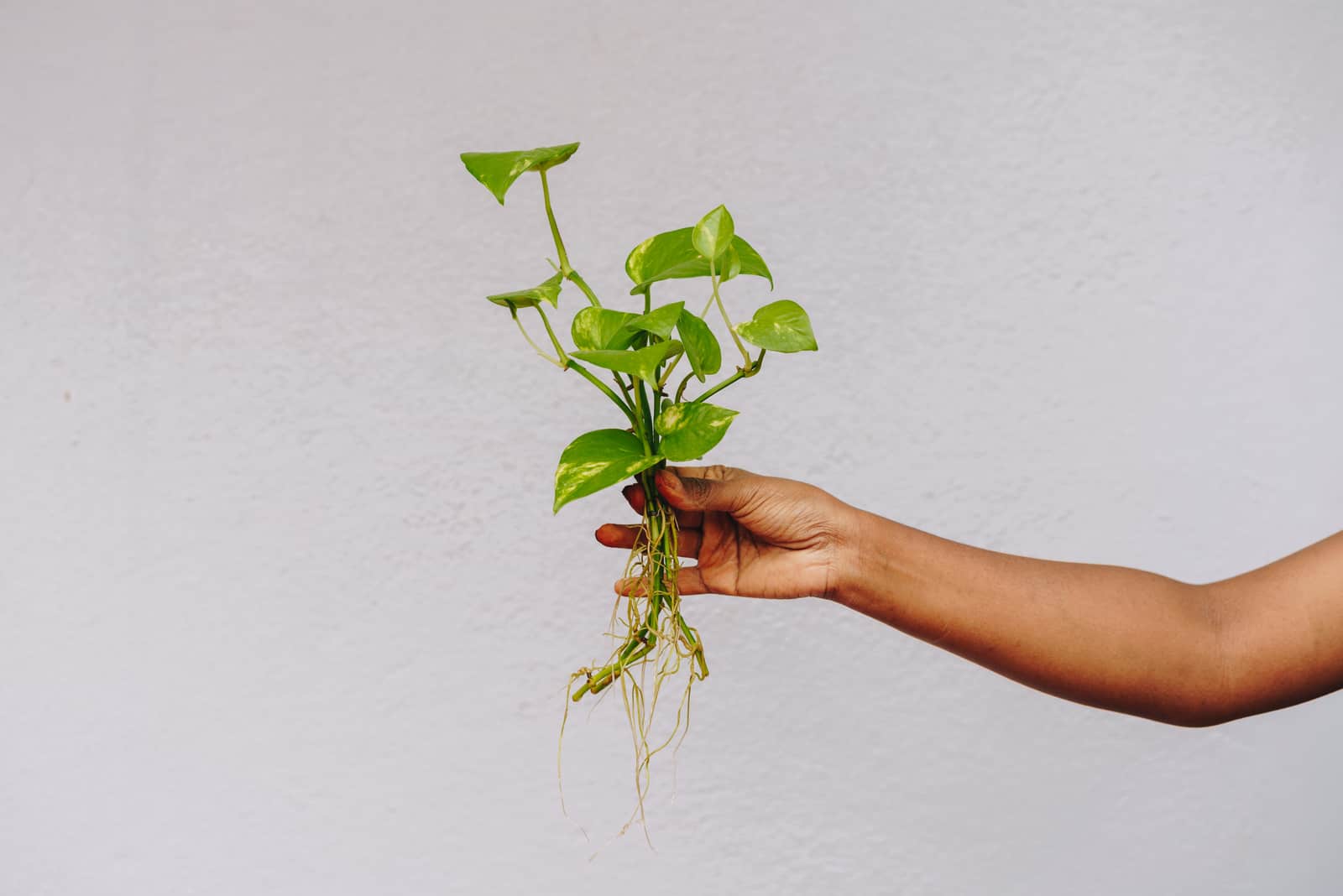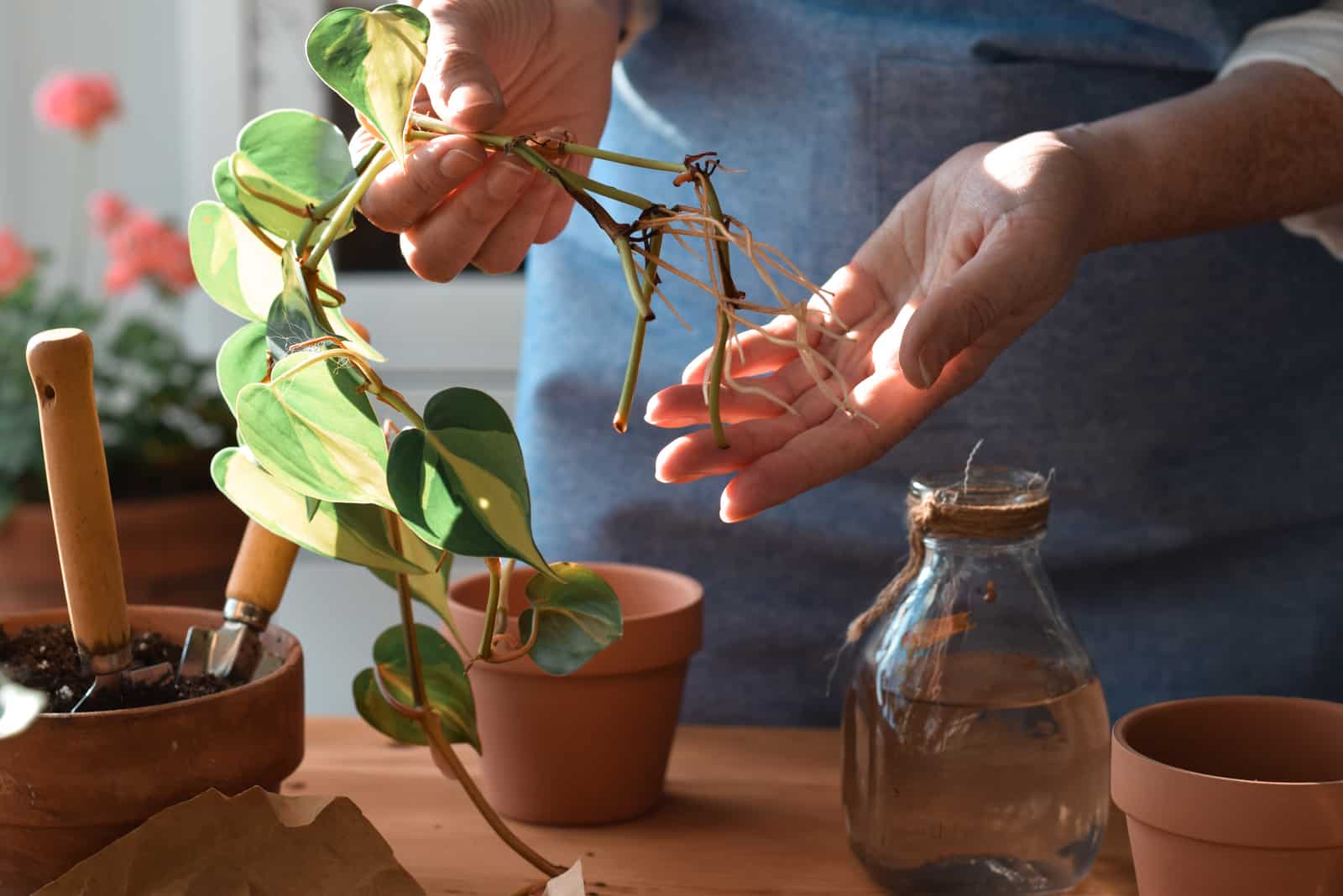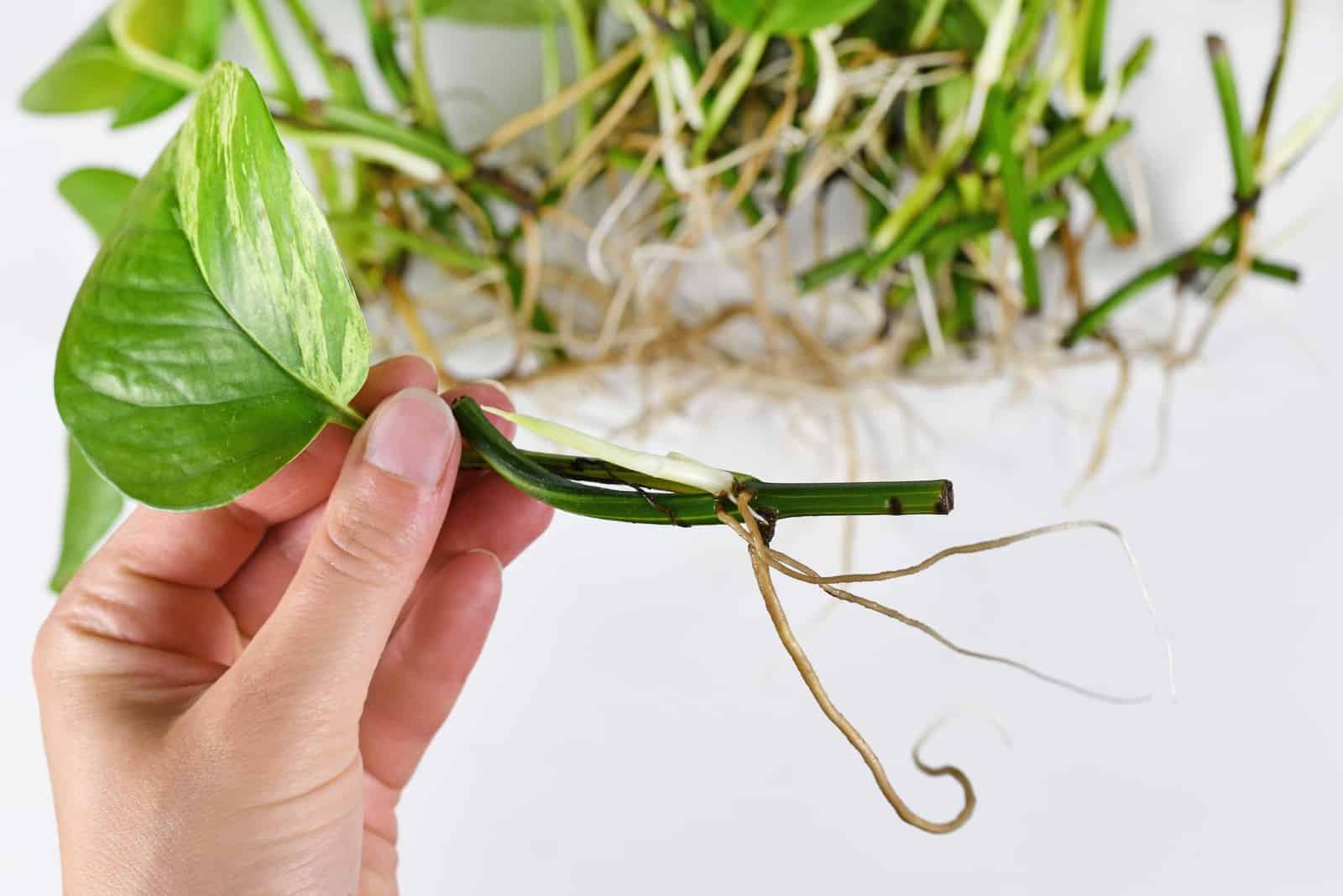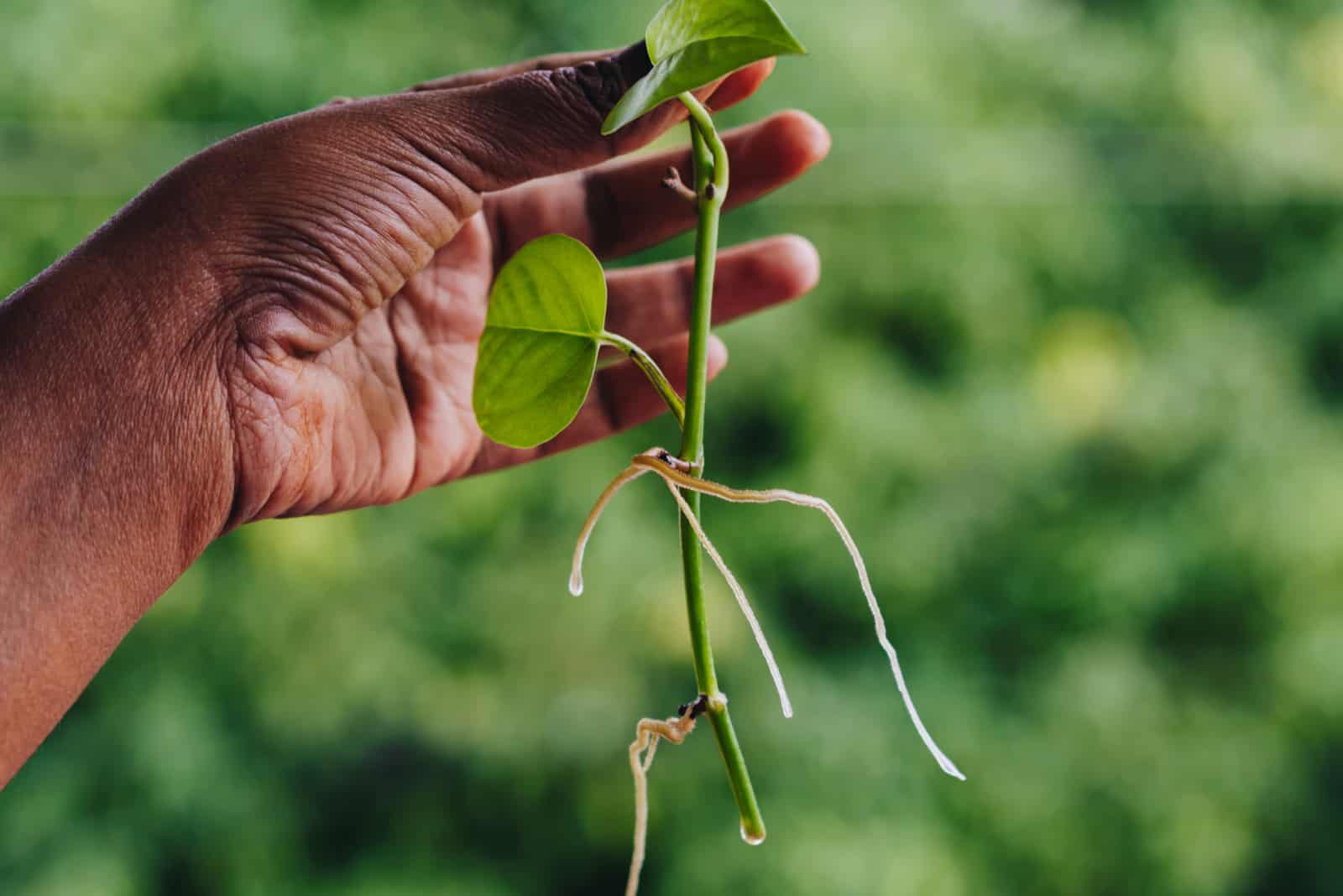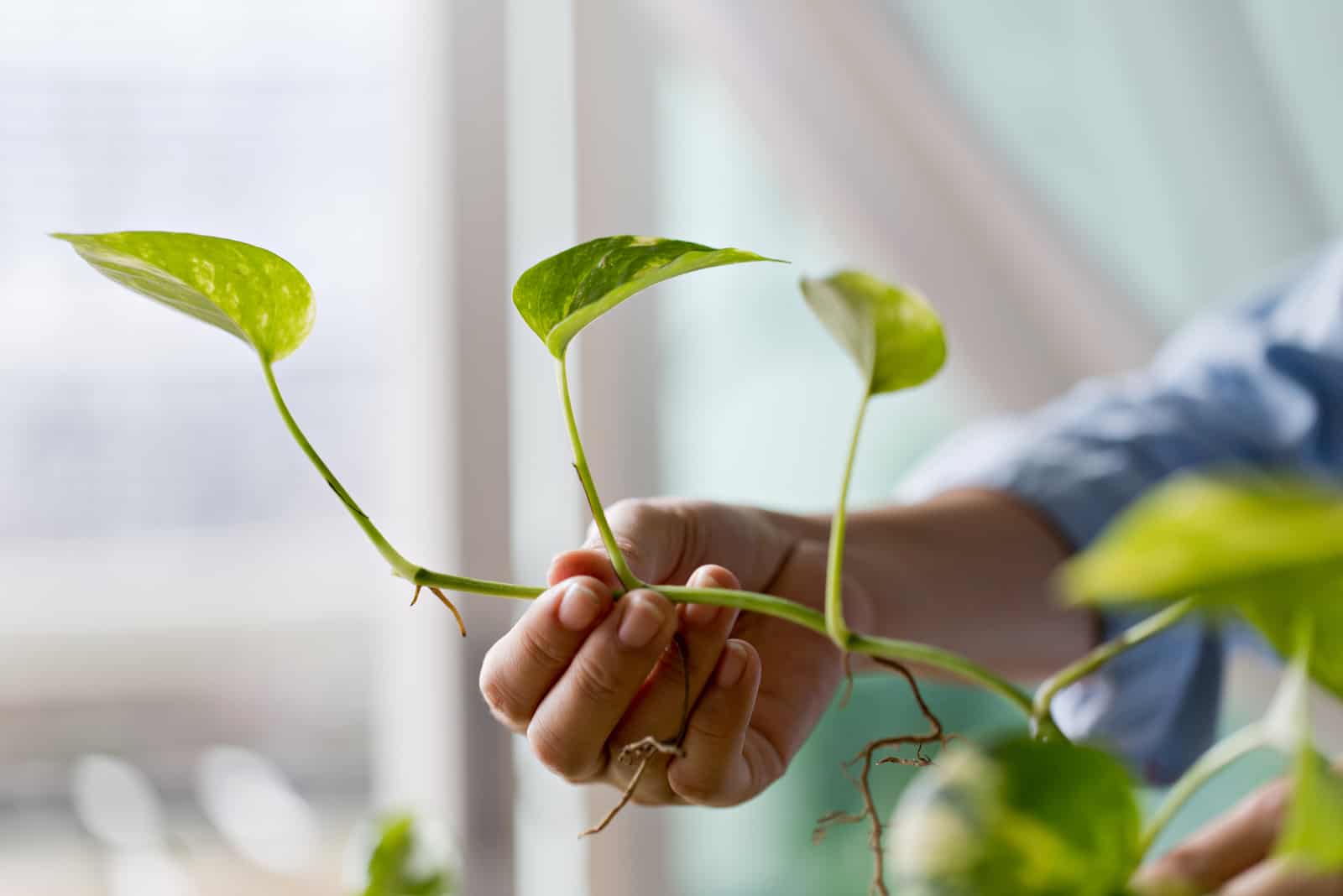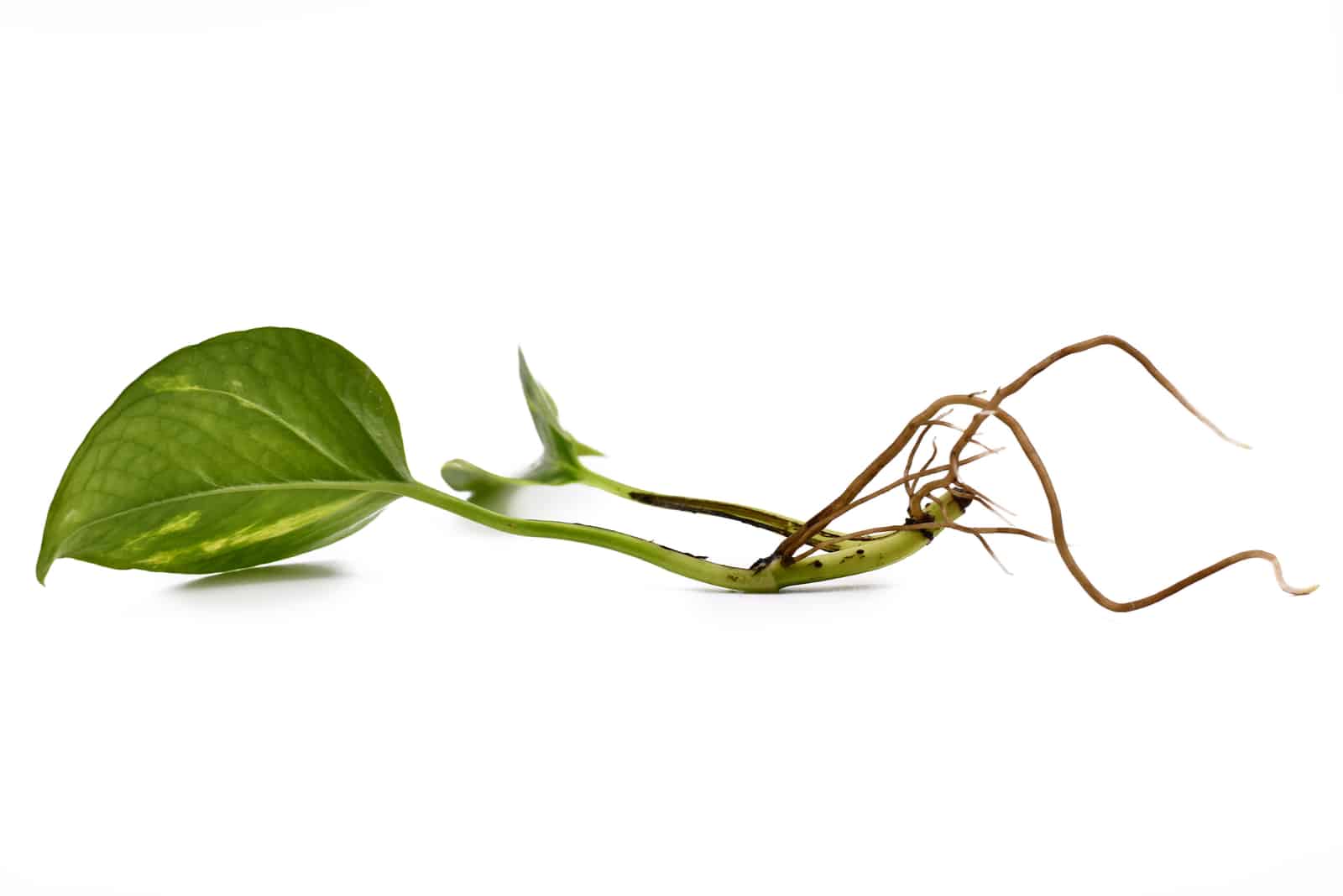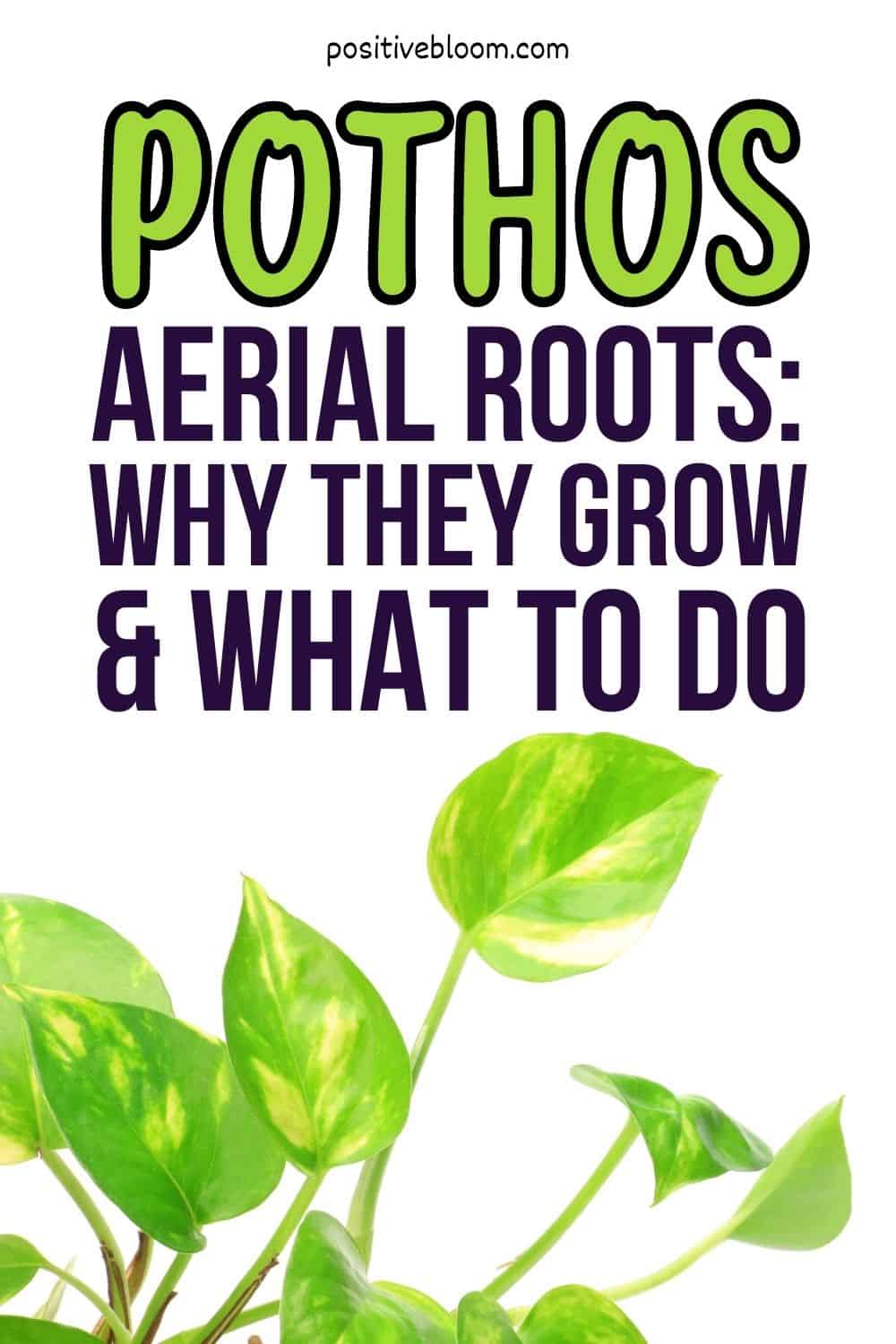When you grow a pothos plant for the first time, you’ll be surprised a lot! In one of their growth stages, pothos plants will develop brown aerial roots.
I’m sure the first thing you’ll do when you notice the roots is wonder if everything is okay with your plant.
The answer is both yes and no; there are many advantages of air roots, but their growth may indicate that something is wrong with your plant.
Don’t worry, I have covered everything you need to know about pothos aerial roots in this article. What air roots are, their function, and how to get rid of them – you’ll get all the answers right here.
Let’s get started!
What Are Pothos Aerial Roots?
Before we move on, let’s first discuss what air roots are. The name says it all – these roots grow above the soil line just like stems and leaves.
Pothos air roots resemble long, sturdy tentacles. These roots are green at first when they grow in their native habitat, and they climb on trees and grow towards the light source.
The air roots won’t take long to turn brown and form a strong outer covering.
The main role of air roots for vining plants like pothos is as anchors. They aid the pothos vines in attaching to other plants in their natural habitat, or trellises and walls when pothos are grown as houseplants or outdoor plants.
Air roots can help the plant to absorb nutrients and moisture. Epiphytes usually develop air roots.
Other common epiphytes that develop air roots are monsteras, philodendrons, and orchids.
However, if you grow succulents and notice they have developed air roots, something is wrong as these plants don’t usually produce them.
The Functions Of Aerial Roots
Pothos plants develop air roots for many purposes. Each plant has different requirements and will develop air roots for distinct purposes.
However, the primary function of air roots is to help the plant adapt and provide support.
Let’s get into details!
They Aid In Nutrient Absorption
There is no big difference between ‘normal’ roots and air roots when it comes to nutrient absorption.
Both types of roots help various plants to absorb nutrients and grow healthy. However, air roots absorb nutrients from the rain that runs down the plant in their native habitat.
Although this function works for pothos, it is more important for orchids because pothos plant air roots are attached to the host.
An orchids’ air roots hang in the air to help the plant get additional nutrients from water pouring from the host plant’s leaves.
They Improve Stability
One of the main functions of this plants’ roots is to aid in stability. Air roots also have this function.
This function is essential for vining plants and epiphytes as they need something to attach to surrounding support structures. These supporting structures help with plant stability and also improve growth.
In other words, the air roots help their parent plant attach to rocks or plants in their natural habitat, or walls and trellises when pothos are grown as indoor or outdoor plants.
The air roots actually serve as anchors, which means they help vining plants like pothos to climb on host trees or walls.
So, how do pothos plants benefit from this function? The first benefit is that the vining plant can climb uninterrupted to reach more light.
Stability is essential for plants like rubber trees, and the air roots add extra strength to soil roots. These plants may grow very tall, so they benefit from having as many roots as possible.
Aerial Roots Help The Plant Breathe
Some plants cannot absorb nutrients from soil roots as they grow in wetlands like coastal swamps, marshes, or bogs. Therefore, they need air roots so they can adapt to growing in such places.
The soil roots of these plants are kind of trapped in marshy water or soil, so they get little to no oxygen.
As the plants don’t have enough oxygen, they need something else to help them breathe. In this case, air roots take over the main role.
In other words, air roots serve as air exchange. This function is especially beneficial for pothos when planted in soil that doesn’t have good drainage.
They Aid In Propagation
This function is very important for pothos. When taking cuttings for propagation, you can select ones that have some air roots attached, which will significantly increase the success rate.
The air roots maintain cuttings and encourage them to continue growing in water or soil.
If you want to accelerate the propagation process, or at least make it easier, select cuttings with air roots attached.
Your plant will absorb more moisture and nutrients to grow the healthiest new leaves, stems, and roots.
They Help With Moisture Absorption
Plants like monstera, pothos, and orchids also use air roots to absorb moisture. It helps them absorb water directly from the soil.
When you grow these plants outdoors, their air roots will help with moisture absorption from rainwater or water falling from the leaves of plants growing above.
What Causes Pothos Aerial Roots To Grow?
Pothos, or Epipremnum aureum, are vining plants that grow as epiphytes in their natural surroundings, which are in the Solomon Islands and other parts of the South Pacific.
This means that pothos grow air roots for climbing or anchoring on to host plants to support their structure.
All pothos varieties, including golden pothos, grow air roots.
Now we also know that air roots help in moisture and nutrient absorption.
Air roots are thick, and you’ll mostly find only one air root that sticks out from the internodes or nodes on the vining stem.
Air roots are not dangerous for your pothos, however, they do look a little bit unattractive.
The strange thing is that some pothos grow air roots, and some don’t.
Here is a list of the causes of air root growth.
High Temperatures
These epiphytes thrive in temperatures between 70 and 90 degrees Fahrenheit. If the temperature drops below 70°F, it may cause temperature stress.
You’ll be able to tell if it’s unhappy because temperatures below 55°F may cause your plant to wilt, wither, and drop leaves.
Your plant won’t be happy if exposed to higher temperatures, either. If you expose your plant to temperatures above 90 degrees Fahrenheit for an extended period, it will display stunted growth.
Temperature stress will also encourage the plant to grow new roots, both aerial and soil.
According to research, higher temperatures appear to encourage the plant to produce air roots.
High Humidity
Pothos’ natural habitat is quite humid. Luckily, they adapt well to lower humidity levels.
However, if you provide your pothos with high humidity it may grow air roots.
High humidity encourages air root growth because your Epipremnum aureum tries to absorb as much moisture from the environment as possible.
Bathrooms, kitchens, terrariums, and greenhouses have higher humidity, so don’t be surprised if your pothos grows air roots in such places.
Low Light
Low light is another reason your plant will grow air roots. It can be seen as an adaptive response as your plant attempts to climb higher in the hopes of catching more light.
If your plant lacks light, it will show other signs apart from air roots, such as legginess.
As a matter of fact, the majority of pothos’ air roots develop on stems that have longer internodes.
If your plant grows in low light for an extended period it may also affect its leaves, which may lose variegations, turn yellow, or droop. Additionally, pothos leaves may also curl.
Your plant may grow really slowly if you don’t provide it with enough light.
The best thing would be to move the plant where it has access to filtered or bright indirect light. Don’t worry, the variegations will be back in no time!
Nutrient Deficiency
Your plant may suffer from nutrient deficiency. If it starts displaying signs like producing air roots, nutrients have likely been in short supply.
Additionally, if your plant lacks nutrients it may show stunted growth,
For example, if your plant lacks Nitrogen, it will most likely lose variegation and its leaves may start turning yellow. The plant will also develop deformed leaves and stems.
Why does this happen? New growth of more air roots can actually be seen as reactionary growth.
This is your plant’s way of trying to absorb more nutrients.
Some of the unhealthy signs above, such as leggy stems, may also be caused by manganese, calcium, or zinc deficiency.
This means that the growth of air roots, deformed leaves, and yellowing may be caused by nutrient deficiency.
Watering Schedule
Now we come to one of the most common issues that affect pothos plants; insufficient watering. This can be both under and overwatering.
Let’s look at the effects of each!
Overwatering
If we compare the consequences of overwatering and underwatering, we can see that overwatering is more damaging because it suffocates the roots and causes root rot.
Your plant will most likely respond to overwatering by producing additional air roots. The plant compensates for root loss below the soil surface as the root system is damaged.
It’s essential to remember that the longer you leave your plant in soggy soil, the more damage it will cause.
As well as growing air roots, other parts of the plant may be affected by overwatering.
Here is a list of other signs of overwatering:
• Leaves turning yellow
• Leaves turning brown
• Drooping leaves
• Soft and black leaves
• Soggy soil
• Foul odor.
If your plant is overwatered, it will most likely need repotting.
Underwatering
On the other hand, if your plant lacks water it will suffer from water stress and stunted growth.
Underwatering is dangerous for your plant because it decreases the roots’ ability for nutrient, mineral, and water uptake. This leads to the unhealthy growth of your precious plant.
Underwatering may worsen the consequences of fertilizer salt build-up.
A lack of water may also encourage your plant to grow air roots so it can obtain more nutrients and water.
Shock
Air roots typically start growing from injured or damaged sections of plants, and you’ll be able to see if you look closely enough.
This may be a result of exposure to the cold, physical damage, or other stressful circumstances. These air roots are not damaging to your pothos in and of themselves.
On the other hand, the air roots could be a sign of stress or that your plant has been damaged or injured recently.
For example, you may have accidentally over-fertilized the plant or bruised the stems.
What To Do?
One of the most common reasons many growers want to remove air roots is because they affect the plant’s appearance.
Air roots are not dangerous, but I’m going to show you a few methods if you want to remove them.
Trim The Aerial Roots Off
The first thing you can do to get rid of air roots is trim them off. Be very careful and sterilize the shears or scissors before you start trimming to avoid contamination.
A great thing is that trimming will not hurt your plant; in fact, it may encourage better and more lush foliage development.
While cutting air roots, try to cut as close to the stem as possible. The closer you cut, the lower the possibility of them growing back.
In my opinion, it’s better to address the issue that caused them to grow in the first place, such as filtered or indirect light, avoiding warmer temperatures, and properly watering your pothos.
Bury The Nodes With The Roots
The second method is burying the nodes with air roots attached in the soil.
This is the simplest and, in some cases, the most effective approach to getting rid of air roots (if they’re unsightly above the soil line).
If you bury air roots in the soil they will start functioning as regular roots and begin to absorb nutrients and water, so it’s a win-win situation.
Use Them For Propagation
Don’t discard air roots after you cut them because they can actually be used for propagation.
Let’s see how!
• The first thing you should do is select a couple of healthy stems. The propagation will be successful if the cuttings have nodes (at least one), air roots, and a few leaves (3-4 should work well).
• I highly recommend you sterilize your garden tools (scissors, shears, pruners, etc.) before each cutting. You should do this if you want to avoid transferring pathogens. Rubbing alcohol or bleach is ideal for sterilization.
• Put on gloves as pothos are toxic plants. They contain a substance known as calcium oxalate. After you finish cutting, wash your hands thoroughly.
• Put the stem cuttings in the soil, water, or vermiculite (vermiculite improves water retention). Remember, you want to keep the soil moist.
You can also place the cuttings in a jar of water. Additionally, your cuttings need to receive a lot of bright, indirect, and natural light, so make sure not to expose them to direct sunlight.
• Wait for about 3 to 4 weeks until the roots sprout in the water.
• After you notice the roots are a few inches long, it’s time to place your propagated pothos cuttings in the soil. The best option would be to use sterilized, regular potting soil.
I know it may sound like too much when it comes to sterilization, but trust me, it increases the chances of propagation a lot as contamination prevents the roots from sprouting.
You will not get a new plant unless you follow each step.
Is It Possible To Propagate Pothos From Just The Aerial Roots?
Many beginner growers wonder if it is possible to propagate plants by using air roots only. Unfortunately, you can’t propagate a new plant with air roots because you will need nodes and leaves.
In case of air roots, propagation doesn’t work because the air roots don’t have the genetic cells specialized to regenerating new plants.
Is It Necessary To Put The Air Roots In Water?
There is no need to place air roots in water because they absorb water from the air.
However, you can place them in water with the stem if you want, although they don’t need water to live.
If you do put them in water, check for root rot every few days and change the water regularly.
More About Pothos Aerial Roots
We have now discovered what air roots are, why they grow, their function, and how to get rid of them.
Now, let’s find out more about air roots (yes, there is more!).
The Air Roots Grow Back
Air roots will grow back, and their task is to climb or grow towards the light source. Additionally, they absorb the nutrients and water needed for the healthy growth of the plant.
When you notice new nubs growing on the plant’s stem, the air roots are growing back.
In some cases, the air roots won’t grow larger if you don’t give them something to climb on.
Air Roots And Pothos Climbing
Fortunately, it is easy to train your Epipremnum Aureum to climb both indoors and outdoors.
Here are a couple of things you can use to help your plant climb:
• Trellis
• A moss pole
• A bamboo pole
• A wall.
All these types of support are ideal for anchoring.
If you grow these plants outside, even a stone wall or a tree can be used.
Once you provide the plant with anchored support, tie the air roots loosely to it. The roots climb up naturally, and if you provide support they will have something to grab.
The air roots will climb up the supporting structure or pole because they have something to grab. In other words, you have imitated their natural habitat, in which they are climbing plants and usually climb trees and use them as support.
Air Roots Aren’t Developing
I mentioned earlier that air roots sometimes won’t grow unless you give them something to attach to. Simply put, if you don’t imitate their natural surroundings, air roots won’t show up.
Therefore, if your plant doesn’t develop air roots it doesn’t mean that something is necessarily wrong.
Air Roots Are Drying Out
We have seen that underwatering may encourage the plant to grow air roots. But if the plant already has air roots and underwatering is combined with low humidity, the air roots are most likely going to dry out.
Your plant is dehydrated and will most likely show other signs, like shriveled leaves and dry soil.
The best way to recover your plant is by changing the watering schedule. When the temperature is warmer, water your plant every 4-5 days.
On the other hand, water every 7-10 days when the temperatures are lower.
Don’t worry, the leaves of your plant will get their green color back and the plant will look stunning again.
Proper watering is essential for plant care, so make sure your plant always receives enough water.
FAQs
How long will aerial roots grow?
Once your plant develops air roots, they will grow as long as the plant. In other words, they will stop growing when the plant matures and reaches full size. New air roots may develop if the plant needs more support.
What is the lifespan of the aerial roots of a pothos?
The lifespan of pothos air roots is the same as the lifespan of the plant itself. These plants may live up to 10 years. However, this depends on many factors, such as the quality of the potting mix, water, light, humidity, temperature, and care in general.
Wrapping Up
I’m sure you will agree with me when I say that pothos plants are incredibly beautiful, especially when they’re grown upwards or downwards in hanging baskets.
Pothos Aerial Roots are not a problem or a sign that something is wrong with your plant. They grow for a reason, which is to help pothos climb even when grown as indoor plants.
Additionally, they absorb nutrients and water and help plants breathe.
You can also use air roots for propagation to improve the success rate.
You don’t have to remove these roots, but if you do decide to remove them, simply trim them off.
You can hide them by burying them in the soil or using them for propagation.
The most important thing to remember is that these roots won’t affect or damage your plant. In most cases, air roots are actually a sign of a healthy pothos.
Until next time!
Like this post? Share or pin it for later!

